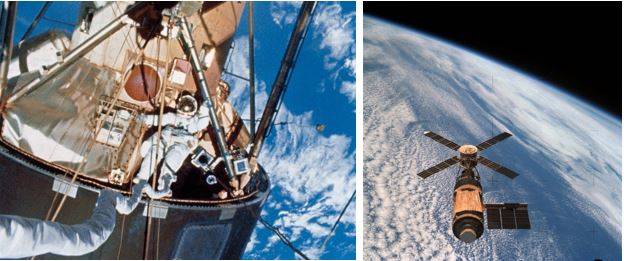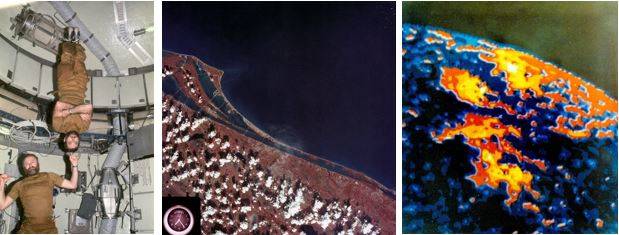The longest human space flight at the time ended on Feb. 8, 1974. The Skylab 4 crew of Commander Gerald P. Carr, Pilot William R. Pogue, and Science Pilot Edward G. Gibson splashed down in the Pacific Ocean after their record-breaking 84-day mission during which they completed significantly more science experiments than planned. Their space flight duration record stood for four years.
Carr, Gibson, and Pogue launched to the Skylab space station on Nov. 16, 1973, and during their first two months on orbit completed three Extravehicular Activities (EVA), or spacewalks, to retrieve and replace film canisters in the Apollo Telescope Mount (ATM) and observe newly-discovered Comet Kohoutek during its close pass to the Sun. The crew also conducted a busy research program, including biomedical investigations on the effects of long-duration space flight on the human body, Earth observations using the Earth Resources Experiment Package (EREP), and solar observations with instruments mounted on the ATM. During their third and final month in space, they wrapped up the experiment work and Carr and Gibson completed the fourth and final EVA of the mission on Feb. 3 with a 5-hour and 19-minute spacewalk to retrieve the last ATM film canisters. It was the last American EVA for nine years.
And then it was time for the crew to mothball the station. Mission Control teleprinted instructions to the crew, which required 15 feet of paper to print! As they finished experiments, they also began to stow gear and samples in the Command Module (CM) for return to Earth. After undocking, they performed an inspection fly-around of the Skylab space station that had been their home for the past three months, and where they were the first crew to spend the Thanksgiving, Christmas, and New Year holidays in space. Reentry and splashdown in the Pacific Ocean went smoothly, and Carr, Gibson, and Pogue, still inside the CM, were lifted aboard the prime recovery ship the USS New Orleans. Because of the additional exercise and better nutrition, the third crew returned in better physical condition than the other two crews who had spent less time in space. The Skylab 4 CM is on display at the Smithsonian’s National Air and Space Museum (NASM) in Washington, DC, where the backup Skylab space station is also on display.
The end of the Skylab 4 mission marked the end of the crewed portion of the Skylab Program. Carr, Gibson, and Pogue configured the station for unpiloted operations, with Mission Control maintaining control of the vehicle. Just before undocking, they fired the Service Module’s Reaction Control System thrusters to raise Skylab’s altitude, and it was predicted that the station would stay in orbit until the early 1980’s. There were discussions of possibly revisiting Skylab once the space shuttle was flying regularly, or at least to have shuttle crewmembers remotely attach a rocket engine to the station to either boost it into a higher orbit or command it to a controlled reentry. Unfortunately, greater than predicted solar activity increased atmospheric drag and caused Skylab to lose altitude more rapidly than expected. Delays in the shuttle program finally made any rescue of America’s first space station impossible. On July 11, 1979, Skylab reentered the Earth’s atmosphere. The forces of reentry caused the station to break up into hundreds of pieces, several large enough to survive to the ground. The debris field extended from the eastern Indian Ocean into Australia, fortunately over sparsely populated areas. Several pieces of Skylab were recovered and now reside in museums.
Skylab was home to three astronaut crews for a total of 171 days, and as a platform for conducting scientific research it proved its value. The biomedical investigations carried out by the nine Skylab crewmembers provided our first glimpse into the effects of long-duration spaceflight on the human body and how to prevent some of the more deleterious effects. The ATM solar telescopes took more than 170,000 images for astronomers, while Earth scientists received 46,000 photographs. In nearly every science discipline, the astronauts exceeded the planned number of investigations. Of significant importance, having humans available for unplanned situations proved highly valuable, from the repair of the space station after its damage at launch, to being able to respond to unexpected events to increase the science return from the mission including observing new solar flares and a comet making a rare passage through the inner solar system. Managers, flight planners, and engineers used the Skylab experience to learn about how to live aboard and operate a long-duration crewed platform in space, passing on lessons learned to later programs like Shuttle-Mir and the International Space Station.
For more insight into the Skylab 4 mission, read Carr’s, Gibson’s, and Pogue’s oral histories with the JSC History Office.






























